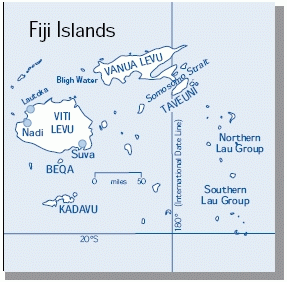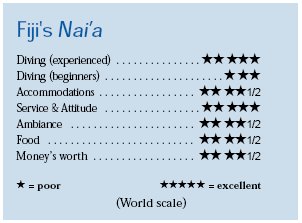Return to Fiji Aboard the Nai’aContents of this Issue: Return to Fiji Aboard the Nai’a NASA, Spit, Soap, and Olive Oil Editorial Office: Ben Davison Publisher and Editor Undercurrent 3020 Bridgeway, Suite 102 Sausalito, CA 94965 Sipping Kava and Flying Fiji Style from the June, 1999 issue of Undercurrent
Dear Fellow Divers: I don’t know whether the grog or the diving on Fiji’s Gau Island was more mind-numbing. The grog, a drink made from the root of the kava plant, certainly did more to squelch all feeling in my lips, but since it tasted like bitter, dirty dishwater mixed with pepper, no one was tempted to drink truly stupefying amounts from the coconut shells that were passed around. And the sevusevu ceremony in the village of Sawaieke, where kava roots were presented and Rob Barrel, owner and captain of the live-aboard Nai’a, asked ritual permission to visit the reefs that are owned communally by the people, was nothing if not exotic: everyone was dressed in sulus--rather like Polynesian pareus--and invited to drink while music played and people danced. But the diving I did during my stay aboard the Nai’a gave me a generous taste of what’s known as the soft-coral capital of the world, and it was unquestionably exotic as well. Try having a cleaner shrimp jump into your mouth and clean your teeth, or fly down the same currents that nourish the soft corals, gliding past numerous pelagics (including four species of sharks), chevron barracuda stacked like logs at the mill, and schools of bigeye trevally that mill about while pairs spin off from the main school to wild courtship excursions. This is exotic diving. Someone once said that “getting there’s half the fun,” but, although Fiji’s not that far for west coasters, the cramped 32-inch seat pitch on Air Pacific’s Boeing 747s becomes extremely uncomfortable long before the end of the 10-hour overnight flight--not the Fiji-style flying I had in mind when I booked this trip! And I was concerned about being in Fiji in March: it’s normally the rainy season, and there’s also the slight possibility of a cyclone.
Nai’a set sail that afternoon after a loud and welcoming “mbula!” followed by a hectic spell of checking c-cards, signing releases, and unpacking while the boat got under way. Nai’a is literally the creation of Rob Barrel, who bought the 120-foot W. deVries Lentsch steel motorsailing yacht in the Caribbean, sailed her half-way around the world, and rebuilt her inside and out. Rob’s sandy-haired, lean, and so relaxed that it’s hard to imagine that he was once on the Harvard prelaw track. Maybe he had trouble imagining it, too: he ended up with a University of California-Santa Cruz degree in anthropology for his studies of dolphin behavior. (A dream he had about a floating laboratory where he could learn a lot about whales and dolphins prompted his purchase of the Nai’a.) The Hawaiian-born sailor and videographer strikes a balance between a business-like temperament and a good sense of humor. He’s ably assisted by Cat Holloway, a blonde, loquacious Australian journalist and underwater photographer who’s also the Nai’a’s divemaster conducting onboard courses in underwater photography and Nitrox use. Once aboard and out to sea, I wandered the cabins and decks comparing the Nai’a to other live-aboards I’d been on. There was enough room on this boat that, with only 13 other American passengers (18 being full occupancy), it wouldn’t be a problem to find a quiet nook if I wanted one. Chaise longues for sunbathers spotted the upper decks, though personally I’ve donated so many biopsies to the dermatologist that sunbathing’s rather lost its charm. All of the boat’s nine soundproofed cabins are done in rich, local woods with grass mats on some walls, and all have portholes and an individual a/c unit that could freeze a side of beef if I cranked it up enough. Only Cabin 10 lacks an en-suite head, though all have showers and plenty of hot water. Some have queen-sized beds, others a queen bed and an upper bunk, and a couple double twin bunks. Most of the cabins are roughly comparable to one another except for Cabins 1 and 2, which are slightly larger but also situated aft where they’re close to engine noise (especially on the first and last nights out when the boat moves a lot). The cabins are warm and ample, not as spacious or luxurious as those on PNG's Paradise Sport, which has a hair dryer in every room, but certainly a cut above the Truk Aggressor’s claustrophobic cabins with their wheezing, asthmatic air conditioners. Cabin 5 would be my pick since it was a spacious queen-bedded room amidships, though rolling wasn’t a problem. There’s a spacious camera room with lots of electrical outlets, and I found that twelve photographers and gear were easily accommodated as long as everyone observed etiquette, although carrying a heavy camera some distance down the narrow hallway was a bit of a schlep that more than one shooter grumbled about. The roomy salon, with two tables that seat up to twenty, serves as a dining/ living/video room with multi-system VCR and TV setup, slide projector, light box, and compact discs. There’s a decent library of fish and critter ID books, an exchange selection of novels, and a video collection of Nova and other oceanrelated videos. Nai’a might not rank first in luxury level, but chef Manasa definitely prepared the best food I’ve had on a live-aboard. The menu was varied and the atmosphere intimate and friendly. There’s a snack seating (cereal, toast, and beverage) before the first dive of the morning with full breakfast later. A typical breakfast offered eggs and smoked marlin or a light French toast with jam or syrup, as well as fruit, muffins, good coffee, and toast. Lunch was usually a lighter, single course such as pasta, fish tacos, or seafood chowder, accompanied by salad and fruit. Although dinner was also casual, it was a full sit-down affair, with soup and hot dinner rolls, a vegetarian dish, and a main course (often lamb, beef, or fresh fish, such as breaded wahoo or rack of lamb), plus fresh vegetables, rice or potatoes, decent, complimentary red and white Australian and New Zealand wines, and well-done desserts like chocolate mousse or lime chiffon pie. Rusi, the Fijian cabin steward and sometimes divemaster, offered personal service, keeping track of things like whether a guest liked red, white, or no wine with dinner. Servings were always sufficient and seconds often available for those in a feeding frenzy. What more could you want? Diving? That was hardly in short supply, although our first dive on day one at Samu’s Reef was certainly not a spectacular location. But there was some macro, and it was a good place to check your gear and trim. A run back to Lautoka allowed dinner at anchor before a late-night departure that I hoped would take us to the good stuff. My first “full” dive was on a seamount called, for obvious reasons, E- 6. E-6 and its nearby twin seamount, Hi8, were discovered by Rob Barrel when he made several reconnaissance flights over Bligh Water searching out new dive sites. This huge bommie’s sheer walls extend to 3,000 feet, and it’s really too large to swim around. Varying currents here mean the diving varies, too, but I always found pelagics when I went where the current was. On one dive here I was treated to a large scalloped hammerhead, an inquisitive gray reef shark, and schools of bumphead parrotfish. This was definitely the good stuff. E-6’s Cathedral is a lovely grotto that’s open to the sun in spots and lined with wide cracks in the rock that lead to rubbly terraces. I followed one down to 83 feet and found a nice octopus den and a large, reddish anemone-like critter I assume was a corallimorph (although nobody on the boat could identify it). I also had one of several encounters with cleaner shrimp here: take your regulator out and put your mouth down on the ledge, I found, and they’ll climb right on in, checking around for whatever’s left of breakfast until you evict them with your tongue. I was entertained by a regular “anemone city” with four species of
anemonefishes, a population so dense that some anemone colonies were actually shared by two species, while one
Clark’s had taken up residence in a
branch of elkhorn coral. After four-dive days, I wasn’t a ball of fire at night. Fortunately, there were quiet activities available on the nights I didn’t do night dives. Rusi played guitar and had a great singing voice. Fijian singing is unique, some of it a sort of musical storytelling, some a choral singing accompanied by string instruments. Rusi’s music was a big part of our village trips and an after-dinner activity in which passengers could join in. Since smoking and alcohol were forbidden the crew, nighttime kava ceremonies with music gave everyone a chance to unwind. The largely Fijian crew of twelve were all friendly and eager to help, and there was a family-like feel to the boat. Things got done in spite of the laid-back tendencies that sometimes make Fiji feel like the Caribbean, the land of “no problem, man.” We were surveyed prior to each dive, given a thorough and illustrated dive briefing, our diver identification tags turned, and our gear loaded onto one of the two 21-foot rigid hull inflatables, or RIBs, from which we did all of our diving. The RIBs, which are launched from a specially-designed dive platform on the transom, made our individual requests for different sites and separate boats for photographers and non-photographers workable options at most locations. Once at the site, the crew assists in donning gear, a back roll gets everyone in the water, and photo/video gear is handed to divers. We had most dive sites to ourselves: informal communication with the Princess II and Fiji Aggressor, the other live-aboards which ply Fiji’s waters, manage to keep boats at different sites. Cat led most of the dives that divers wanted led, and Rusi had good eyes for finding small and rare critters. No dive limits were enforced; the five daily dives (including one night dive) are scheduled so there’s plenty of surface interval for off-gassing. Computers are encouraged, any disturbance of the environment discouraged. Boarding RIBs without a ladder is often less than graceful, but the crew did give a tug or assisting pull when needed. The lack of grace is more than compensated for by the other big advantage of having two RIBs--the ability to set up a shuttle back to Nai’a. Nobody had to get frustrated at the guppy-breathing macro photogger who stays down forever or at the air chuffers ready for a shower in half an hour. The ever-waiting RIBs are there for the shuttle back to Nai’a. At this point I’d often head for a hot, outdoor shower, warm towel, something to drink, a munchie, and maybe a quick nap before doing more diving. Other days I’d relax in the salon between dives along with other passengers working on logs, checking ID books, napping, or talking about dives. Cat’s courses were usually going on in a corner of the room while other passengers sunned upstairs. There were a couple less-than-stellar dives mid-trip that made me worry that dive quality was returning to the level we’d experienced at Samu’s Reef--not that they were utter duds, just low viz, fast current dives that weren’t really productive. If we’d been offered the chance to choose, I would have chosen an alternative dive: a speeding drift dive in murky water, as happened at “Nai’a Flya,” was not my cup of tea, and the nearby reef was teeming with life waiting to be seen and videoed. By the time we got to Grand Central Station (named for its schools of pelagics), dives were back on track. I was greeted by an immeasurable throng of chevron barracuda followed by swarming redtooth triggerfish and a veritable park of garden eels, some of them a yellowish orange. I followed the current upslope to The Arch, a natural rock arch big enough to provide passage for a nuclear submarine, its surfaces festooned with soft and hard corals and populated with dozens of fishy denizens. From here, a downcurrent drift and some faith--dive briefings are that good--brought me to a pair of bommies called Kansas and Yellow Brick Road, their tops overgrown with soft coral that in the current looks amazingly like windblown wheat fields sprinkled with a kaleidoscope of small fish. On occasion, Rob does a low-impact shark feed. A ball of tuna heads with line frozen into them is run through a bolt attached to a rock, and the line is pulled down. The sharks get a taste of food, but not enough to habituate them or make them dependent on visiting divers. The group of 19 well-behaved gray reef sharks, mostly females (three or four younger males), came in one by one (or in pairs) and partook of some tuna head. They kept circling, coming by and giving each diver a good looking over, allowing plenty of opportunity for frame-filling photos. Tip: Two huge Javanese morays inhabit a hole at the shark feed site, so it would pay to look where you decide to sit for the performance. They are calm, but I wouldn’t want them to feel I was blocking their way. My concern about the March weather turned out to be unfounded. My trip was gloriously sunny with water temps about 83° F. I did 34 dives in 9 days. One or two had poor enough visibility that I kept my sense of perspective, but most of Fiji’s “flying” in currents is not to be missed: the pelagics, the incredible variety of soft corals, and the anticipation of the current’s potential gifts-- encounters with hammerheads, gray reef sharks, mantas and more--seldom disappointed me. Nai’a anchors at calm dive spots at night, and the night dives were among the best. I’ve looked for shy, light-averse bearded cuskeels for years, and I saw my first one here one night, looking like a large, dull-black tadpole with long fins. He would have been easy to overlook in the midst of the “balolo” phenomenon, when swarms of the reproductive segments of Eunice polychaete marine worms, traditionally gathered by Fijians for a celebratory meal, find divers’ lights an irresistible target. Myself, I’m already thinking of my next trip (over half the passengers aboard were return guests). Having done several other live-aboards, I like this boat, and I’ll be back for another trip. I seem to have developed a thirst for “Fiji flying.” —— L. J.
|

I want to get all the stories! Tell me how I can become an Undercurrent Online Member and get online access to all the articles of Undercurrent as well as thousands of first hand reports on dive operations world-wide
| Home | Online Members Area | My Account |
Login
|
Join
|
| Travel Index |
Dive Resort & Liveaboard Reviews
|
Featured Reports
|
Recent
Issues
|
Back Issues
|
|
Dive Gear
Index
|
Health/Safety Index
|
Environment & Misc.
Index
|
Seasonal Planner
|
Blogs
|
Free Articles
|
Book Picks
|
News
|
|
Special Offers
|
RSS
|
FAQ
|
About Us
|
Contact Us
|
Links
|
3020 Bridgeway, Ste 102, Sausalito, Ca 94965
All rights reserved.

 After lots of research and deliberation,
I’d chosen the Nai’a for my second
trip to Fiji. She leaves from
Lautoka, a forty-minute bus ride from
the airport at Nadi, but since I arrived
at 6:00 a.m. and the bus picking
me up for our 2:00 boarding wouldn’t be
there till 1, I figured a dayroom,
which covers you till 5 p.m., would be
a good investment in comfort. I was
right.
After lots of research and deliberation,
I’d chosen the Nai’a for my second
trip to Fiji. She leaves from
Lautoka, a forty-minute bus ride from
the airport at Nadi, but since I arrived
at 6:00 a.m. and the bus picking
me up for our 2:00 boarding wouldn’t be
there till 1, I figured a dayroom,
which covers you till 5 p.m., would be
a good investment in comfort. I was
right. I used up
every microampere of battery and my
tape, finally deciding to ascend after
an hour and twenty minutes.
I used up
every microampere of battery and my
tape, finally deciding to ascend after
an hour and twenty minutes. Diver’s Compass: To contact Nai’a, call 1-800-903-0272 (U.S.), 011-
679-450382 elsewhere, fax 011-679-450566, or airmail P. O. Box 332,
Pacific Harbour, Fiji Islands; website at
Diver’s Compass: To contact Nai’a, call 1-800-903-0272 (U.S.), 011-
679-450382 elsewhere, fax 011-679-450566, or airmail P. O. Box 332,
Pacific Harbour, Fiji Islands; website at 